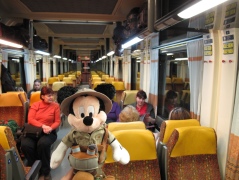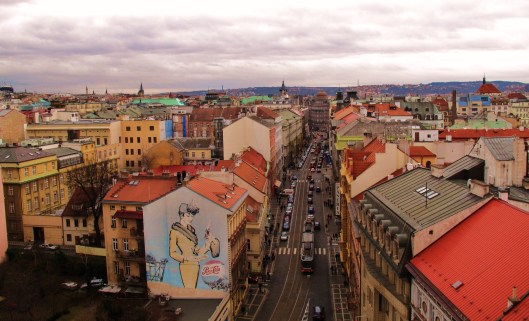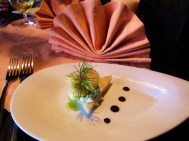Tags
Central and Eastern Europe, Czech dolls, Czech Republic, Czeska Republicka, Jan Jesenius, Mickey Mouse plush, Prague, Prague National Gallery, Prague red roofs, Praha, Tower in a Tower, train from Budapest to Prague, travel
“He who seeks does not find, but he who does not seek will be found.”
–Franz Kafka
Prague had been something of an afterthought; it was Budapest I longed to see. But everyone I talked to seemed to have more enthusiasm for Prague and told me I would see for myself when I got there. I still do not understand why. When I look back on our first afternoon in Prague, I remember the grating noise of our suitcases on cobblestoned sidewalks, I remember the impatient tenseness of the crowds waiting for trams, and I remember the slate gray sky with its roiling clouds. Mostly, though, I remember being confused. Where was the Prague of legend, the Paris of Eastern Europe, the diamond among the pearls? Where was the Prague of Dvorak and Janacek? More than once, I thought that we should have done Vienna instead. But then I would never have seen St Vitus Cathedral, and that is a memory I would rather not do without.
 That morning, we took the 5:25 a.m. train EC 174 Jan Jesenius from Budapest to Berlin, which dropped us off in Prague at 12:18. We had bought our tickets at Keleti Station the day before for much less than the price online. I fell asleep with my head against the window as the darkness faded to blue over the stooped shoulders of rural houses. When I woke up, my friend was in a state. The train had just passed through Slovakia and she was frightened. “You didn’t see!” she said. “It’s already getting better.”
That morning, we took the 5:25 a.m. train EC 174 Jan Jesenius from Budapest to Berlin, which dropped us off in Prague at 12:18. We had bought our tickets at Keleti Station the day before for much less than the price online. I fell asleep with my head against the window as the darkness faded to blue over the stooped shoulders of rural houses. When I woke up, my friend was in a state. The train had just passed through Slovakia and she was frightened. “You didn’t see!” she said. “It’s already getting better.”
 I looked out now on the bleak countryside of the Czech Republic. Dilapidated houses, factories, warehouses lined the sides, graffitti snarling on every wall. Snow smothered the long stretches of fields between settlements. With mountains came forests, not just wispy trees that lose their vitality in winter, but pines, tall and austere like sentries out of some nightmarish tale. Perhaps it was only the weather. I fervently wished that the people in these towns have bright summers with stars and flowers.
I looked out now on the bleak countryside of the Czech Republic. Dilapidated houses, factories, warehouses lined the sides, graffitti snarling on every wall. Snow smothered the long stretches of fields between settlements. With mountains came forests, not just wispy trees that lose their vitality in winter, but pines, tall and austere like sentries out of some nightmarish tale. Perhaps it was only the weather. I fervently wished that the people in these towns have bright summers with stars and flowers.
Further north, the houses grew taller. An unrelenting sun hung in the sky. The snow on the ground thinned and was then replaced by silvery pools of water. Fields began to show hints of green. We spotted a white horse disappearing around a bend on a country lane. If you wanted to plow a field, would you buy a white horse to do it? we asked each other. But if not, what else would you want a white horse for?
We got off the train not knowing what to expect.  The station was sleek. Outside, the streets were crowded with cars and people. However, I had the fleeting impression that compared to Budapest, people’s faces looked more careworn. But there is no reason why that should be the case; both the Czech Republic and Slovakia are supposed to be more prosperous than Hungary. Maybe I was only projecting my weariness onto them. Interestingly, on our way to the hotel, we saw a guy out walking his ferret.
The station was sleek. Outside, the streets were crowded with cars and people. However, I had the fleeting impression that compared to Budapest, people’s faces looked more careworn. But there is no reason why that should be the case; both the Czech Republic and Slovakia are supposed to be more prosperous than Hungary. Maybe I was only projecting my weariness onto them. Interestingly, on our way to the hotel, we saw a guy out walking his ferret.

We stayed in a hotel close to Wenceslas Square and the National Gallery in the New Town (founded in 1348–ha, that’s history for you. This number is how I came to respect Prague). I know now, as I did not know then, that our impression would have been very different had we stayed in one of the less complicated and more peaceful parts of the city.

Shops lined the avenue. The first Czech word we learned was “sleva”–sale–which clamored for attention from banners in every display window, including the one below with beautiful Czech dolls:
 The National Gallery was too daunting to go in. Black with soot, it sat like a deep sea creature waiting to swallow anyone who wandered into its jaws.
The National Gallery was too daunting to go in. Black with soot, it sat like a deep sea creature waiting to swallow anyone who wandered into its jaws.
We walked in the direction of a tower that resembled something in my guide book. I mistook it for the Powder Tower that is the hallmark of Prague. We rode an elevator to the top, opened the latches on the creaky windows, and looked appreciatively at the red roofs Prague is famous for. I made sure to keep a tight hold on Keats so the wind did not blow him away.
We shrieked when the bell rang in the tower. It felt like someone had sneaked up to clang cymbals in our ears. We escaped from its attacks through a steep staircase.
One floor below, we came across a restaurant called Tower in a Tower. We were seated before heavily shuttered windows showing the sheer drop down, and then, to our great amazement, handed menus the size of a codex, complete with curly Medieval texts. We were also each given a glossy shrimp appetizer. I ordered a ragout, heavy stew with several kinds of meat in it. Heartened by our meal, we ventured out into the unpredictable city again.








